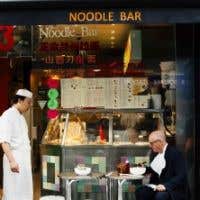This article was also published in the Financial Times.
Gerald Diffey, the dapper Englishman behind Brooks, the highly successful restaurant in Melbourne, Australia, was back in London, principally, I gleaned, to take his friends and family to discover the capital's latest restaurants.
He had just approved of the pour from the bottle of Verget 2009 Chablis the waiter had offered him at The Quality Chop House in Farringdon Road, EC1, and a smile crept across his face. 'You know, Nick', he said, 'I love this business and I hope I always will. But there is one expression that always annoys me and that is when people refer to 'industry norms'. What makes the life of the restaurateur so attractive in my opinion is that it is still relatively easy for a determined individual to establish somewhere exciting that is in complete contravention of what are laid down as "industry norms".'
Diffey's words stayed with me and as I look back on another year in which I have been so fortunate to eat and drink so well, I realise that it is primarily thanks to those individuals who, consciously or not, have defied restaurant norms.
Take the most memorable beginning and end of two evenings that took place over 7,000 miles away from each other.
The first was in the Mission district of San Francisco, California. My wife was just reading the menu pinned inside the window of the Heirloom Café when she began to smile as broadly as Diffey. Here, proprietor Matt Straus, turns the normal corkage policy of so many restaurateurs on its head. Come with a bottle that is 10 years or younger and the corkage charge is $25 per bottle; but come with an older, more recherché, bottle and the charge is a mere $10.
The entire evening at La Pineta at Marina di Bibonna on the Tuscan coast was a delight from the stroll along the beach beforehand to enjoying Luciano Zazzeri's version of panzanella with mackerel and the cool capellini with mullet roe as well as his catholic wine list.
But what brought a smile to my face at the time, and will be my longest-lasting memory from this meal, will be what happened at the end of dinner. Then Zazzeri, hitherto chef and restaurateur, becomes the cashier. And in this unlikely role he creates the opportunity for a final few words with his customers, who during the evening had been absorbed in their own conversations.
Looking through my articles what also struck me is how much pleasure three very different restaurants, Goust, Le Sergent Recruteur and La Table des Anges, in Paris have given me. They underline a growing conviction that, having reached a low point, the quality of restaurants across France's capital is now finally becoming more exciting.
What also excited me about these three restaurants is that although they are disparate in style they are quintessentially Parisian. La Table des Anges in the 9th is the combination of the culinary skills of Yan Duranceau in the basement and the relaxed bonhomie of Jacques-Henri Strauss as he surveys his dining room from behind the bar. Nothing, and certainly no customer, escapes the attention of Enrico Bernardo, chef turned sommelier turned restaurateur as he zooms around the perfectly formed first-floor restaurant that is Goust in the 2nd arrondissement. And while it is more difficult to spot chef Antonin Bonnet in the far end of Le Sergent Recruteur's kitchen on the Île St-Louis, a restaurant underwritten by a wealthy, anonymous backer, his culinary finesse is obvious on the plate.
But whatever sum Monsieur X has invested in this one restaurant, it must be far more than collectively has been spent by five other determined individuals in three London restaurants and one in Singapore.
Liangming Qiu is the chef at the Lanzhou Lamian Noodle Bar (pictured above) by Leicester Square station where bowls of steaming noodles with numerous toppings cost no more than £7. The seating is cramped, the service invariably swift and Qiu is undoubtedly the most diffident chef I have ever interviewed.
Certain of these traits are shared by Andy Lim, the genial chef at Le Chasseur in Singapore, where the vast number of dishes on his menu are written on the walls alongside their respective cholesterol counts.
Back in London, Andrew Wong has invested wisely in taking over the restaurant that once belonged to his parents close to Victoria Station where he is cooking some of the most distinctive Chinese food in town. But even he must doff his hat in terms of pounds spent per impact generated to Sarit Packer and Itamar Srulovich, the husband and wife team behind the exceptional Middle Eastern food at Honey & Co, who transformed a former café for £30,000 into such a warm and exciting space. From such humble beginnings will appear their first cookbook in July 2014.
My contravention of the eating out norm took place in the tavern of Gramercy Tavern in New York with a couple whose long friendship demanded, I believed, a particularly memorable wine. As I ordered a magnum of 2005 Nuits-St-Georges, Clos de la Maréchale from JF Mugnier for US$465, my wife looked on in surprise while my friend's wife whispered in my ear, 'How did you know red burgundy is my favourite wine?'
Finally, my ideal day would encompass two sets of restaurateurs who, by incorporating their entire families into what they do, distinguish themselves not just in the warmth of the hospitality they provide but also by proving that family life can survive the pressure of restaurant life.
So after dinner, bed and breakfast in Ballymaloe, Ireland, in the care of the Allen family, I would like to fly directly to Girona, Spain, for a late lunch prepared and served by the Roca brothers at El Celler de Can Roca. Such a flight does not currently exist, but I can always dream.
Photograph by Greg Funnell, reproduced by kind permission of the FT.

